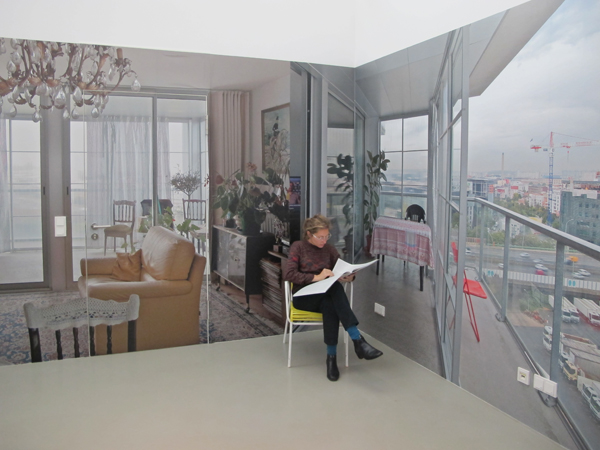









Druot, Lacaton & Vassal – Tour Bois le Prêtre
Exhibition on the transformation of a residential tower from the 60s
---
Curated by Ilka & Andreas Ruby in collaboration with Something Fantastic
DAM (German Architecture Museum), Frankfurt, 06.10.2012-13.01.2013
DAZ (German Architecture Center), Berlin, 15.02.-31.03.2013
---
“You don’t really gain anything by demolishing an edifice and rebuilding it in the same place with a contemporary look”. In 2004 French architects Frédéric Druot, Anne Lacaton and Jean-Philippe Vassal caused a real stir with their study “PLUS – Les grands ensembles de logements – Territoires d’exeception”, proving as they did that an existing building with three to four-room apartments can be modernized and enlarged for the same amount of money that it costs to demolish and rebuild it. The proof of the proposed architecture recycling stands in the north of Paris, its 16 storeys looking out over the Boulevard Péripherique: the Tour Bois le Prêtre. Built in 1961 by Raymond Lopez as an elegant residential highrise with split-level and maisonette apartments, remodeled beyond recognition in the 1990s as part of refurbishment of the building services engineering and 2011 transformed by Druot, Lacaton & Vassal into a completely new residential building.
With just a few interventions the architects succeeded in creating larger apartments and new service facilities by converting the former oversized access zones. “It is the solution on the inside that determines the appearance on the outside,” the architects said by way of explaining their method of working. The Tour Bois Le Prêtre, for example, received a new sheath, which at the same time created new space for the small apartments. The old facade was replaced by a new one made of glass, in front of which, as with scaffolding, additional modules can be hung. These consist of winter gardens and balconies, separated from one another by floor-to-ceiling movable sun protection panels. This adds an extra 26 square meters to what was previously a 44-square meter apartment.
As was to be expected on the basis of comparable projects, the upgrading of the Tour Bois Le Prêtre did not set in motion a driving-out process among the old tenants. All the inhabitants, some of whom had been living in the building since 1959, were included in the planning processes and stayed, as the rent is still affordable. Many of Lacaton & Vassal’s projects are a contemporary answer to the demands made at the 1929 CIAM Congress, which set the standards for the “subsistence level apartment”.
For this reason the transformation of the Tour Bois le Prêtre is more than just an architecture project. It offers architects, planners, conservationists, developers and politicians a model for the physical and social rehabilitation of the housing constructed for the masses in the 1960s and 1970s in France and elsewhere. The “plus principle” can ultimately be used for all buildings with curtain, not load-bearing facades.
The exhibition staged by DAM in cooperation with the European Central Bank in the context of the EUROPEAN CULTURAL DAYS France 2012 was curated by Ilka and Andreas Ruby together with Something Fantastic. It presents the Tour de le Prêtre project in the form of a frieze featuring life-size (2.50-meter high) images of the inside of the apartments, which goes all around the walls on the top floor of DAM (in total some 50 meters long).
Furniture, plants, and other fittings have been placed in front of the frieze, such that the photos give visitors to the exhibition the feeling that they are actually in one of the apartments. At the same time, the living rooms represented on the walls appear to virtually enlarge Oswald Mathias Ungers’ museum space. Sitting in one of the numerous chairs, armchairs or sofas perusing the catalog to find out how this stunning transformation was possible, you almost forget that you are in a museum. For a moment you feel as if you yourself live in a 134-square meter apartment on the 14th-floor of the Tour Bois le Prêtre, with a view of Paris, a winter garden and a balcony, all for 700 euros rent.
This sort of residential quality is possible if buildings are converted rather than demolished, a much discussed topic in Germany as well. For this reason the exhibition also presents a study for the transformation of “Juridicum”, the law faculty building on the Bockenheim campus of Frankfurt university, a classic post-War building, which is earmarked for demolition and replacement by a new structure. The study was conducted by the architect Ana Filipovic, a recent graduate of the Staedel School who for the duration of the exhibition, with a team, will elaborate the project in the “Building within a Building” on the third floor. Shortly before the exhibition ends in January 2013, her project will be presented to the public in DAM. An accompanying discussion with politicians, representatives from the housing construction industry, and real estate developers, is intended to address concrete ways of also giving the “Juridicum” in Frankfurt/Main a new structural and programmatic purpose using the approach adopted by Druot, Lacaton & Vassal.
---
→ Visit DAM
→ Visit DAZ
→ Visit Something Fantastic
→ Visit Lacaton & Vassal
→ Visit Frèdèric Druot Architecture
→ Check out the publication on Ruby Press
→ Read an interview with Anne Lacaton in Der Standard
→ Read a review in Deutsche BauZeitschrift
→ Read a review in BAUNETZWOCHE
→ Read a review in Journal Frankfurt
→ Read a review in Frankfurter Neue Presse